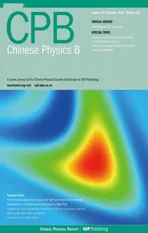Multibeam Raman amplification of a finite-duration seed in a short distance∗
2021-10-28Chen陈雨谷Chen陈勇Xie谢善秀Peng彭娜Yu余金清andXiao肖成卓
Y G Chen(陈雨谷) Y Chen(陈勇) S X Xie(谢善秀)N Peng(彭娜) J Q Yu(余金清) and C Z Xiao(肖成卓)
1Key Laboratory for Micro-/Nano-Optoelectronic Devices of Ministry of Education,School of Physics and Electronics,Hunan University,Changsha 410082,China
2Collaborative Innovation Center of IFSA(CICIFSA),Shanghai Jiao Tong University,Shanghai 200240,China
Keywords: multibeam Raman amplification,growth rate,finite-duration
1. Introduction
Laser intensity is limited to the optical intensity of gratings, which is a critical issue for chirped pulse amplification(CPA) technology,[1,2]due to damage threshold. Therefore,amplifiers based on plasma medium, whose tolerant intensity is about 104–105times of solid-state optics,[3]was proposed. Malkin, Shvets, and Fisch proposed the basic principle of compressing the laser beam to highly overcritical power via stimulated Raman backscattering (SRBS).[4–8]It is based on the three-wave interaction,in which the pump wave,backpropagating seed pulse,and Langmuir wave should satisfy the phase matching condition. The seed pulse absorbs the power of the pump wave and gets an intensity much higher than the pump wave in the nonlinear stage of SRBS, so it is called backward Raman amplification(BRA).[4,6,9]This scheme will lead to high-intensity seed pulse even in the exawatt regime by using plasma as the medium.[4,6,10–13]The BRA concept has been theoretically[4,6,14–18]and experimentally[19–23]explored a lot.
Collective modes of multibeam stimulated Raman scattering (SRS), which have higher growth rates than the single beam one,have been discovered for many years,and they are hazardous to the inertial confinement fusion.[16,17,24,25]However,this feature may facilitate Raman amplification. The idea of using multiple laser beams in Raman amplifier was first proposed by Balakinet al.[26]to suppress noise and enhance focusability. Their analysis was limited to paraxial approximation where the beam angles are only few degrees, so it is actually a modified BRA.In our consideration,multiple laser beams overlap with large incidence angles as seen in laser facilities such as National Ignition Facility(NIF).[27]Under that circumstances, we can use the advantage of a large number of laser beams to provide a higher Raman growth rate. But one should also note that due to overlapping the amplification length is finite. Typical amplification time,w/csinϕ, is only about 2–3 picoseconds,wherewis the beam width,ϕis the angle of incidence,andcis the speed of light. Therefore,how to achieve higher seed intensity in such a short distance is one of the main issues in the multibeam Raman amplification(MRA).
In this paper, we demonstrate proof-of-concept numerical studies by focusing on the simplest case of two-beam amplification. Geometry of MRA and its linear growth rate are studied first. We use a collective mode by sharing a common scattered light to accomplish MRA,and its growth rate is proportional to the square root of the beam number. Unlike the conventional BRA regime,finite-duration seed is used here to take advantage of the growth of the initial seed pulse. Since a second pulse (the Raman Stokes wave) trailing the original seed pulse grows from zero amplitude, if the seed duration is negligible, it will take a considerable time for the second pulse to reach the unchanged initial seed amplitude. While using finite seed duration,the original seed pulse can directly gain energy from the pump beams instead of waiting for the growth of the second pulse. We find that the real-amplitude growth rate is a function of the initial seed amplitude,electron temperature, and seed duration. For a fixed seed amplitude,the growth rate saturates atγ0τc=1, whereγ0is the linear growth rate andτcis the critical seed duration. This formula gives us a proper choice of seed duration for amplification.We also find by performing three-wave coupling simulations and two-dimensional particle-in-cell(PIC)simulations that the growth rate of two-beam amplification is much larger than that of the single-beam amplification. After the initial exponential growth,the two-beam amplification enters the nonlinear stage more rapidly and shows features of pulse compression and a bow-shape wave front, which indicates the amplification has entered the self-similar(π-pulse)regime.
The paper is organized as follows. In Section 2, we present a brief derivation of multibeam linear growth rate based on the full wave coupling equations. Simulation models are discussed in Section 3. In Sections 4 and 5, we show how finite-duration seed pulse can gain energy from two pump beams in a short distance through three-wave coupling simulations and 2D PIC simulations at the linear and nonlinear stages. We summarize the MRA scheme in Section 6.
2. Linear growth rate of MRA
In the conventional BRA scheme,pump laser(ω0,k0)and seed pulse (ωs,ks) are coupled by Langmuir wave (ωlω,klω)through phase-matching condition:ω0=ωs+ωlωandk0=klω −ks, as shown in Figs. 1(a) and 1(c). The physics can be described by the three-wave coupling equations of fluid limit[4,28]
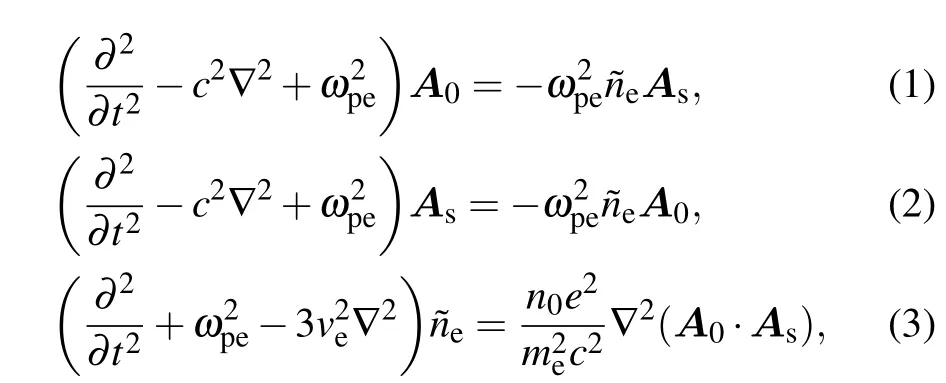
whereAsandA0are the vector potentials of the scattered light wave and the pump wave, respectively, and ˜neis the electron density fluctuation of the Langmuir wave. In addition,ωpeis the plasma frequency,veis the electron thermal velocity,eandmeare the charge and mass of electron.
AssumingA0=const.and performing Fourier transform on Eqs.(2)and(3), we can get the linear dispersion relation.The growth rate of BRA in homogeneous plasmas is readily obtained by solving the dispersion relation[29]

wherevos=eA0/mecis the electron oscillation velocity.
The linear growth rate of multibeam Raman scattering[16,30,31]can be derived from those equations as well just by consideringA0as a superposition of multiple laser fields. The process to get the dispersion relation is similar to the single-beam one(see detailed derivation in Ref.[16]). The difference is that MRA relies on collective modes that geometrically symmetric pump lasers share a common scattered light.[16,25,32]The geometry of a two-beam amplification is shown in Figs. 1(b) and 1(d) where a seed pulse propagates along the bisector of two pump wave vectors.

Fig. 1. (a), (b) are the diagram of single-beam amplification and twobeam amplification,respectively. Wave number matching condition of(c) single-beam amplification, where the scattered light is opposite to the direction of the pump laser;and(d)two-beam amplification,where the geometrically symmetric pump lasers share a common scattered light.
In the MRA,the maximum growth occurs when the seed pulse is resonant with all multiple pump lasers through symmetric and obliquely propagating Langmuir waves,

3. Simulation models
The full-wave Eqs. (1)–(3) are usually simplified to the first order equations by using envelope approximation. But for a large angle of incidence,the Laplace operator ∇2cannot be separated via paraxial approximation.[26]One must solve the full-wave equations to capture the correct dynamics in the transverse direction.
Here, we use two simulation models. First, by totally neglecting the transverse behaviors,the first order three-wave coupling equations are derived along the symmetric axis as

wherea0,a1, anda2are envelopes of the pump laser, seed pulse, and Langmuir wave, respectively.V0x=k0xc2/ω0,Vs=−ksc2/ωs,andVlωx=3klωxv2e/ωlωare the group velocities of the three waves along thex-axis, andγ0=a0Γis the linear growth rate of MRA. Actually, this model is very accurate for describing BRA,but we use it to capture the rough behavior in the longitudinal direction just by substitutingγBRAwithγ0. We have solved the three-wave coupling equations numerically to obtain the linear growth pattern of Raman amplification resulting from different seed durations.
Further, a more radical model, i.e., PIC simulation, is used to study the whole linear and nonlinear stages of twobeam amplification. 2D PIC simulations via a full threedimensional, relativistic PIC code EPOCH[18,33,34]are performed.
The simulation parameters are as follows. We specify the wavelength of the pump laserλpump=800.0 nm with an intensity of 2.0×1014W/cm2. The seed pulse is a Gaussian beam withλseed=888.9 nm,and the full width at half maximum of the seed amplitude is 8µm. The amplification length for each case is 320µm and the box width is 80µm. The entire simulation box is filled with uniform plasmas of density 0.01nc(nccorresponds to the critical density of the pump laser),buffered by vacuum regions of 10µm on both sides of longitudinal direction. The electron temperature is 10 eV and the ions are set to be immobile. The transverse boundary condition is set to be open boundary condition in order to prohibit artificial perpendicular scatterings.[25]When the pump lasers fill in the simulation box, the seed laser is incident from the right hand side of the simulation box. There are 80 particles in each cell and the spatial resolution is 0.04µm/cell.
The schematic of single-beam Raman amplification is shown in Figs.1(a)and 1(c),where the pump laser is incident from the left of the simulation box and the entire simulation time is 2400 fs. The geometry for two-beam Raman amplification is shown in Figs.1(b)and 1(d),where two plane pump lasers are injected from the upper and lower boundaries of the simulated box with a same incidence angle.The entire simulation time is 1600 fs. The duration of the seed pulse is changed in cases.
4. Amplification at the linear stage
4.1. Real-amplitude growth rate
We measure the real-amplitude growth rate of the amplification, which shows the growth of the maximum seed amplitude. As shown in Figs. 7(b) and 8(b), the maximum amplitudes of the seed pulseAseedare extracted from the simulations and we plot log(Aseed/Aseed0) as a function of time,whereAseed0is the amplitude of the initial seed pulse. The real-amplitude growth rate is thus obtained through a linear fitting over time. Note that the real-amplitude growth rate is not exactly equal to the theoretical growth rates discussed in Section 2.
Figure 2 shows the comparison of the theoretical growth rates and the real-amplitude growth rates with different initial seed amplitudes,electron temperatures,and incidence angles of two pump beams from PIC simulations. The pump intensity is 2.0×1014W/cm2, while the seed intensity increases from 5.0×1012W/cm2to 2.0×1014W/cm2. The theoretical growth rate (black curve, evaluated from Eq. (6))decreases with the increase of the incidence angle since the Langmuir wavenumberklωis decreasing. The tendency of real-amplitude growth rates (marked lines) is consistent with the theoretical results very well.

Fig. 2. Theoretical and real-amplitude growth rates of two-beam amplification as a function of incidence angle at different original seed intensities and plasma temperatures. The intensity of both pump lasers is 2.0×1014 W/cm2.
It is observed that the real-amplitude growth rate strongly depends on the initial seed amplitude. When the seed amplitude is weak enough, compared to the pump intensity, the real-amplitude growth rate is close to the theoretical one as verified by the red-dotted curve. As the seed amplitude increases to the pump level,the effect of the seed amplitude on the growth rate cannot be neglected. Thus,the growth rate decreases by nearly a factor of 2. Landau damping also plays an important role in the growth rate. As the temperature goes up, the real-amplitude growth rate decreases as shown in the blue-up-triangle curve and purple-down-triangle curve.
4.2. Finite-duration seed to facilitate MRA in a short distance
For mulitbeam Raman amplification with large incidence angle,amplification proceeds in a finite length on the order of beam width. Therefore,conventional scheme of using enough long amplification length is not appropriate for MRA. Here,we use a finite-duration seed to achieve higher seed intensity.
As we know, analytic solutions of Eq. (7) at the linear stage (a0= const.) can be obtained through Green functions.[34–36]Assuming the initial valuesa2(x,0)=0 anda1(x,0) =a10e−x2/D2, the spatio-temporal evolution of the seed pulse is[35]
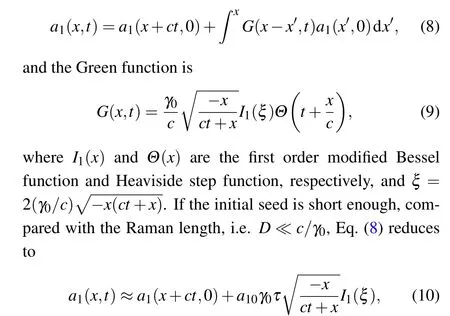
whereτis the seed duration(full width at half maximum).
The solution involves an initial seed pulse propagating with the speed of light (the first term) and a pumped pulse excited by the resonant interaction (the second term). The maximum growth of the pumped pulse occurs atx=−ct/2,growing with the homogeneous growth rateγ0. Nevertheless,the real-amplitude growth rate is defined by the growth of the maximum ofa1(x,t). Ifτis negligible,not until the maximum of the pumped pulse reachesa10, the real-amplitude growth rate remains null. The timet0to reach the initial seed amplitude is approximated byI1(γ0t0)=1/γ0τ, which increases logarithmically asτvanishes. Whenτis finite, both two terms contribute to the growth of the seed pulse, so the realamplitude growth rate is a function of duration,γ=γ(τ).
To demonstrate this effect, we numerically solve Eq. (7)and plot evolutions of the seed pulse with finite durations in Fig. 3. Here the pump and seed pulse intensities are 2.0×1014W/cm2and 2.0×1012W/cm2,respectively,and this corresponds to a two-beam growth rateγ0=4.90 ps−1. When the initial seed duration is 48 fs, a fast-growing second pulse gradually appears at the tail of the original seed and it broadens over time as shown in Fig.3(a). Att ≈1600=679 fs,the second pulse catches up the original seed,which is accordant with the estimation,t0≈629 fs. The leading pulse propagates at a speed of 2.944×108m/s and it has a small growth rate of 0.690 ps−1; while the second pulse propagates at a speed of 1.677×108m/s and it has a growth rate of 4.166 ps−1close to the theoretical growth rate. When the duration is long enough,τ=573 fs in Fig. 4(b), the leading pulse keeps its original envelope shape as the amplitude grows. The amplitude maximum propagates at a speed of 1.940×108m/s and the realamplitude growth rate is 4.277 ps−1. Since it grows from the original seed pulse,it can achieve higher amplitude in the same amplification length.

Fig.3. Evolution of seed amplification at various times through threewave coupling simulations. The seed pulse has a short duration of 48 fs in (a) and a long duration of 573 fs in (b). The seed laser intensity is 2.0×1012 W/cm2,and the pump laser intensity is 2.0×1014 W/cm2.
Next, we apply the idea to study the MRA in multidimensions and compare the efficiencies of single-beam amplification and two-beam amplification. Figure 4 shows the evolution of the seed envelopes along the center line of the simulation box in a 2D single-beam Raman amplification process. The intensities of the pump laser and seed pulse are both 2.0×1014W/cm2, and the duration of the seed pulse is (a)30 fs and(b)100 fs,respectively. As the seed pulse enters the simulation box,its normalized amplitude isAseed=0.0103 at 1.42 ps. A second pulse forms later and broadens over time.After passing through 320µm,the amplitude of the seed pulse is almost unchanged,Aseed=0.0108 att=2.22 ps, since it takes so much time for the second pulse to be amplified from noise. While in Fig. 4(b), the seed pulse is amplified rapidly with only one peak. It shows good agreement with the analyses of the three-wave coupling equations.

Fig.4. (a)Time history of seed pulse envelope at y=0 with the pulse duration 30 fs. (b) Time history of seed pulse envelope at y=0 with the pulse duration 100 fs. The intensity of each pump laser and seed laser pulse is the same,2.0×1014 W/cm2. The seed laser pulse enters the simulation box at(a)t =1.23 ps and(b)t =1.27 ps,and stops the amplification at t=2.22 ps.
Figure 5 shows the evolution of the seed envelopes along the center line of the simulation box in a two-beam Raman amplification with an incidence angle of 30°. The duration of the seed pulse is(a)30 fs and(b)100 fs,respectively,and the intensity of the pump lasers and seed pulse is 2.0×1014W/cm2.In Fig. 5(a), the duration of the seed pulse is broadened first and then compressed, accompanying with the amplitude increased rapidly. At the end of the simulation,t= 1.6 ps,the seed amplitude increases toAseed=0.0269,which is 2.36 times of the initial amplitude. In the whole simulation,we observe the formation of the second pulse,but the second pulse is growing fast even when the duration is only 30 fs.In Fig.5(b),there is a small broadening in the seed pulse, and the amplitude is increased more rapidly than that in Fig.5(a).No second pulse is formed in this case.

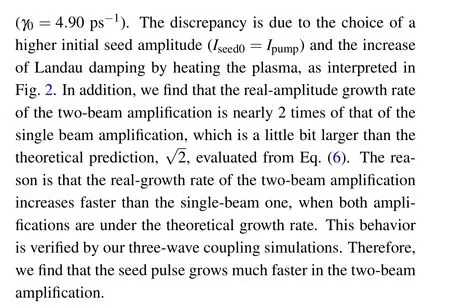

Fig.5. (a)Time history of seed pulse envelope at y=0 with the pulse duration 30 fs. (b)Time history of seed pulse envelope at y=0 with the pulse duration 100 fs. The intensity of each pump laser and seed laser pulse is 2.0×1014 W/cm2. The seed laser pulse enters the simulation box at(a)t =0.615 ps and(b)t =0.65 ps,and stops the amplification at t=1.60 ps.
Figure 6 also helps us to choose a proper seed duration to facilitate the MRA with higher growth rate. We summarize the rules of growth by an empirical criterion

under a fixed initial seed amplitude. Below the critical duration,the real-amplitude growth rate gradually increases,while above that the growth rate begins to saturate. We have verified the criterion from our PIC simulations thatτc=280 fs for the single-beam amplification is close to the saturation point of black line in Fig.6,τ ≈250 fs,andτc=200 fs for the twobeam amplification is just the saturation point of red line in Fig.6,τ ≈200 fs.Due to the higher growth rate,the two-beam amplification has an advantage of choosing a much shorter duration.
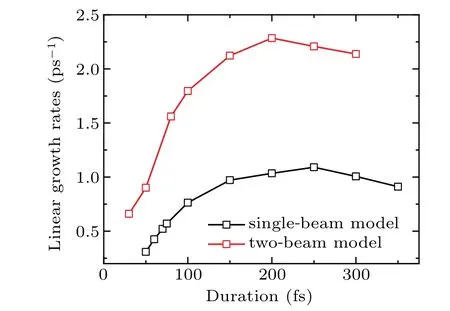
Fig. 6. The simulated growth rates of the seed pulse as a function of seed duration. Black line is single-beam model, and red line is twobeam model with the incidence angle of seed laser being 30°. In the two models, the intensity of each pump laser and seed laser pulse is 2.0×1014 W/cm2.
At the critical duration, the seed pulse has both a higher growth rate and initially shorter duration.Its shape is well preserved in the whole amplification process without triggering an apparent second pulse tailing behind the initial seed pulse.Thus,it helps the seed to gain more energy in a finite amplification length.
5. Amplification at the nonlinear stage
The above analyses are based on the linear amplification where the amplitude increases exponential with time. However, when the seed amplitude is large enough that the pump depletion cannot be ignored,amplification enters the nonlinear stage. Pulse compression is a key character at the nonlinear stage, and it leads the amplification into a self-similar (orπpulse)regime,where the amplitude of the seed pulse increases linearly with time while the seed duration decreases linearly with time. In this section,we show how two-beam amplification enters the nonlinear stage in a finite amplification length of 320 µm and the effect of finite duration on the nonlinear amplification.
The spatio-temporal evolution of the seed amplitude in the single-beam amplification is shown in Fig. 7(a). The initial seed duration is 100 fs and other parameters are mentioned above. The growth factor (log(Aseed/Aseed0)) reflecting the evolution of the maximum amplitude is shown in Fig.7(b),and it is find that the amplitude of the seed pulse increases exponentially in the whole amplification process, which indicates that the single-beam amplification is still in the linear stage.At the end of the simulation the amplitude of the seed pulse is increased toAseed=0.0203,which is 1.845 times of the original seed amplitude. The spatio-temporal evolution shows that no pulse compression is observed at this stage,though the seed has already passed 320µm.

Fig.7. (a)Evolution of seed amplification at various time. The duration of the seed pulse is 100 fs,and the intensity of each pump laser and seed pulse is 2.0×1014 W/cm2. The seed laser pulse enters the simulation box at t =1.27 ps,and stops the amplification at t =2.22 ps. The amplitude in z-axis is 1000 times its initial amplitude. (b) Growth of the maximum seed pulse amplitude in the logarithmic scale, and its linear curve fitting.

Fig.8. (a)Evolution of seed amplification at various time. The duration of the seed pulse is 100 fs, and the intensity of each pump laser and seed laser pulse is 2.0×1014 W/cm2. The seed laser pulse enters the simulation box at t=0.65 ps,and stops the amplification at t=1.6 ps.The amplitude in z-axis is 1000 times its initial amplitude. (b)Growth of the maximum seed pulse amplitude in the logarithmic scale, and its linear curve fitting.
Next, we study the nonlinear evolution of the two-beam amplification. Two pump laser beams are incident fromymaxandyminwith an incidence angle of 30°and the seed duration is 100 fs. Other parameters are the same as the previous ones.The spatio-temporal evolution of the seed amplitude at various time is shown in Fig. 8(a). After interaction, the intensity of the seed pulse increases toAseed=0.0384,which is 3.46 times the initial amplitude of the seed pulse. Figure 8(b)shows the growth of the maximum seed amplitude in logarithmic scale(black dots)and in linear scale(blue dots). It is clearly shown that exponential growth lasts for only 240 fs, from 0.7 ps to 0.94 ps, and its duration is broadening until the amplitude reachesAseed=0.0165. Whent>0.94 ps,the seed pulse enters the nonlinear stage, where the seed amplitude increases linearly with time,accompanying with a pulse compression as seen in Fig.8(a). In addition,the pulse has reformed to a bow shape, which is also a nonlinear feature of Raman amplification. These nonlinear features indicate that the amplification has come into a self-similar regime. Thus, we conclude that the seed pulse enters the nonlinear stage much faster in twobeam amplification than in single-beam amplification due to higher growth rate.
At last,we discuss the effect of duration on the nonlinear amplification. To achieve a higher intensity, the initial seed intensity is increased to 2.0×1015W/cm2. Two different seed durations are presented in Fig.9,i.e.,(a)100 fs,(b)50 fs,and(c) 50 fs. At the end of the simulation,t=1.6 ps, the seed amplitude in Figs.9(a)and 9(b)grows toAseed=0.0541 andAseed=0.0607, 1.59 times and 1.79 times of the initial seed amplitude (Aseed0=0.034), respectively. In Fig. 9(c), when further increasing the pump intensity to 4.0×1014W/cm2,the seed pulse grows toAseed=0.085, which is 2.46 times the initial seed laser amplitude. Due to the choice of finite duration to facilitate MRA,both of the final amplitudes are higher than the cases before. When the initial seed intensity is high enough,we find that larger seed power(larger duration)is not friendly in keeping the pulse shape as shown in Fig.9(a)where multiple peaks occur in the seed pulse. While small seed duration helps maintain the pulse shape due to high growth rate and slight wavebreaking. Also, an obvious bow shape of the seed pulse is formed. Besides,we observe that the transverse scale of the pumped pulse is getting larger in the nonlinear stage,since the Langmuir waves excited by the two beams are obliquely propagating as shown in Fig.1(b). This effect may enhance the efficiency of energy transfer and is good for the subsequent focusing stage. The comparison suggests that a proper short duration without triggering the second pulse can result in higher amplification intensity and better output pulse shape.

Fig.9. Evolution of seed amplification at various time in the two-beam amplification. The duration of seed pulse is(a)100 fs, (b)50 fs, (c)50 fs.The seed intensity is 2.0×1015 W/cm2.Each pump intensity is 2.0×1014 W/cm2 in(a),(b),and 4.0×1014 W/cm2 in(c).The amplitude in the z-axis is 1000 times its initial amplitude.
6. Discussion and conclusion
In this paper, we propose a new scheme of multibeam Raman amplification in virtue of the collective mode by sharing a common scattered light. This scheme takes the advantage of larger growth rate through increasing the laser beams,however, this also limits the amplification length. Therefore,we suggest to use a finite-duration seed to facilitate MRA in a short distance. The reason is that finite-duration seed has a real-amplitude growth rate, growing from the original seed amplitude. This growth rate depends on the initial seed amplitude, electron temperature, and seed duration. By using 2D PIC simulations, we have shown that the real-amplitude growth rate of two-beam amplification is much higher than that of the single-beam amplification. An empirical criterion,γ0τc= 1, is used to choose a proper duration for a higher growth rate. Also,the duration has influences on the nonlinear stage of amplification. The two-beam amplification quickly enters the nonlinear stage where pulse compression and a bow shape occur. These nonlinear features indicate that the amplification has come into a self-similar regime.


Acknowledgement
We are pleased to acknowledge useful discussions with Qing Jia.
猜你喜欢
杂志排行
Chinese Physics B的其它文章
- Physical properties of relativistic electron beam during long-range propagation in space plasma environment∗
- High winding number of topological phase in non-unitary periodic quantum walk∗
- Widely tunable single-photon source with high spectral-purity from telecom wavelength to mid-infrared wavelength based on MgO:PPLN∗
- Control of firing activities in thermosensitive neuron by activating excitatory autapse∗
- Adaptive synchronization of chaotic systems with less measurement and actuation∗
- Dynamics analysis of a 5-dimensional hyperchaotic system with conservative flows under perturbation∗
